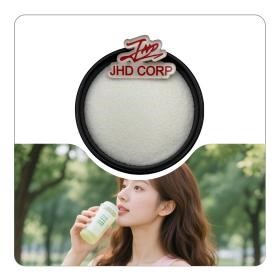Welcome to JHD Nutrasource!
Shop
Trimethylglycine
Trimethylglycine, also known as betaine, is a naturally occurring compound. It is derived from choline through a series of enzymatic reactions in the body. Chemically, it has a structure with a trimethylammonium group and a carboxylate group. It appears as a white, crystalline powder that is highly soluble in water and has a slightly sweet taste.
Description
| Product Name | Trimethylglycine |
| Appearance | white crystalline powder |
| Specification | ≥98% |
| Test Method | HPLC |
| Source | through a chemical process |
| Certificate | USP/EP/JP/Kosher/Halal/GMP |
| CAS No | 107-43-7 |
| MF No | C₅H₁₁NO₂ |
Function
- Osmotic regulation: It helps maintain the osmotic balance in cells. In organisms exposed to high – salt environments or during certain physiological conditions, trimethylglycine can accumulate in cells to counteract the osmotic stress caused by high salt or other solute concentrations, thereby protecting cells from dehydration and damage.
- Methyl donor: It serves as a major source of methyl groups in the body. These methyl groups are essential for various biochemical reactions, including DNA methylation, which plays a crucial role in gene regulation and genomic stability. It also participates in the synthesis of important molecules such as creatine, carnitine, and phosphatidylcholine.
- Homocysteine metabolism: Trimethylglycine is involved in the metabolism of homocysteine. It donates a methyl group to homocysteine, converting it to methionine. This process helps to maintain normal levels of homocysteine in the blood. Elevated levels of homocysteine are associated with an increased risk of cardiovascular diseases, so trimethylglycine plays a role in reducing this risk.
Application
- Food industry: It is used as a food additive. In baking, it can improve the texture and volume of bread by enhancing gluten formation. It is also used in some processed meats to improve flavor and reduce the formation of harmful compounds during cooking. Additionally, it is added to certain energy – boosting drinks and supplements due to its role in energy – related metabolic processes.
- Cosmetics and personal care: In cosmetics, trimethylglycine is used for its moisturizing properties. It can help retain water in the skin, making it feel softer and more hydrated. It is also used in some hair care products to improve the condition of the hair and enhance its shine.
- Pharmaceutical and nutraceutical fields: It is used in dietary supplements, especially those formulated to support liver health, as it can help with the detoxification processes in the liver. It is also used in some medications and supplements aimed at reducing the risk of cardiovascular diseases by regulating homocysteine levels. In addition, it may be used in the treatment of certain medical conditions related to abnormal methylation processes, such as some neurological and psychiatric disorders.

